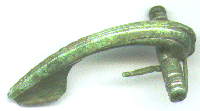|
|
|
 |
This bronze book clasp
or hasp was found in England early in 1998 along the
Thames foreshore (river bank area concealed at high tide,
but revealed at low). It is 2 3/8 x 1 5/16 inches (58 x
33 mm), with a patina of various greens, retains remnants
of two rivets with which it was attached, and is
decorated with a design of pierced and stamped (or
engraved) circles. Variants of this design were used all over Europe through the fifteenth century. They became smaller in the sixteenth century before disappearing in favor of ribbon ties or no fastenings. Typically such clasps as this were riveted to leather straps that would wrap around a book, keeping its pages flat when not in use. This is an especially interesting object considering how very few literate people there were during these times. Of the few books that were created, most were written in Latin, very few in the vernacular. It was in the middle of the fifteenth century that Johann Gutenberg (German, c. 1400-c. 1468) devised his innovative printing process employing moveable type. Gutenberg's Mazarin Bible (c. 1455) is considered the first book printed with such type. Books printed during the first fifty years of the use of movable type, from c. 1455 until 1501, are known as incunabula (a Latin word meaning "swaddling clothes" and "cradle"). So this hinge was used in the binding of either a codex (handwritten book) or of an incunabulum, among the first of the printed ones |
 |
Iron Age Ox
Head Bucket Mount "Bucket mount"? That didn't sound very exciting when this artefact was identified. However, we're not talking "plastic bucket under the sink" here - the British Iron Age farmers held their buckets in high regard and they were valued possessions. There would have been a pair of these ornate bronze ox-heads mounted on either side of the bucket. The handle would be attached to the loops at the top of each mount. You can see good examples of these buckets at the British Museum. |
 |
Roman Dolphin
Brooch This example of a roman brooch is known as a dolphin brooch. Roman brooches come in all shapes and sizes, these include knee brooches, disc brooches and animal brooches such as the one above. |
 |
Roman
Tortoise This tortoise was found near to a similar cockerel and increases the likelihood that they came from a shrine. The tortoise and the cockerel would have originally been part of a group which would have had Mercury as the main figure. The other missing item is a ram or goat |
 |
This silver-gilt thimble seems likely to date from the second half of the 15th century. Posy rings of that date have similar legends in black letter with similar fronds of foliage between the words. Like posy rings, this thimble would also have been a lover's gift, presumably to someone whose name began with an E. Black letter at this period is notoriously difficult to read, and in this case is also somewhat damaged, but we provisionaly suggest it reads 'pens de moi', think of me. |
The Find Pages And Other Links